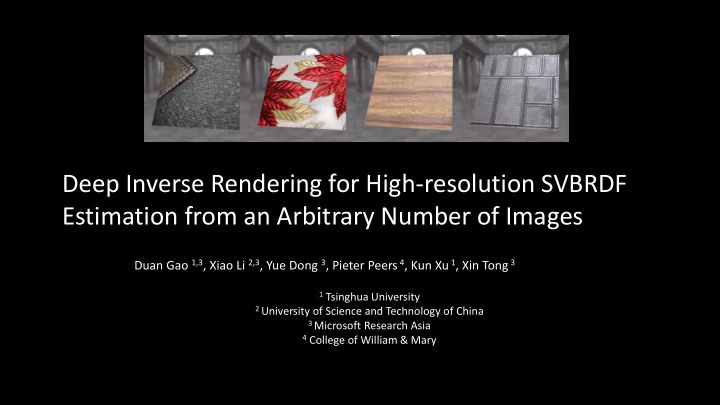

Deep Inverse Rendering for High-resolution SVBRDF Estimation from an Arbitrary Number of Images Duan Gao 1,3 , Xiao Li 2,3 , Yue Dong 3 , Pieter Peers 4 , Kun Xu 1 , Xin Tong 3 1 Tsinghua University 2 University of Science and Technology of China 3 Microsoft Research Asia 4 College of William & Mary
Rendering 1
Materials Geometry Material 2
Appearance Estimation 3
Related Work • Classic Inverse Rendering • Multi-Image Heuristics-based Appearance Modeling. • Single/Few Image Reflectance [Aittala et al. 2015] [Dong et al. 2014] Modeling • Learning-based Appearance Modeling [Li et al. 2018] [Deschaintre et al. 2018] 4
Our goal Unified framework 5
Three lighting conditions Challenges Reference Non-trivial to combine current solutions • Learning-based methods: Render hard to extend to arbitrary number of inputs 6
Three lighting conditions Challenges Reference Non-trivial to combine current solutions Render • Classic Inverse Rendering: failed when input number is insufficient. 7
Our goal Single Plausible … Multiple Accurate 8
Assumptions • Planar object • Point light source collocated with the camera • Fix distance between object plane and camera 9
Overview Key Idea: Deep Inverse Rendering SVBRDF auto-encoder SVBRDFs Multiple measurements 10
Overview Key Idea: Deep Inverse Rendering SVBRDF auto-encoder SVBRDFs Multiple measurements 11
Overview Key Idea: Deep Inverse Rendering SVBRDFs Multiple measurements 12
SVBRDF auto-encoder 13
Training SVBRDF auto-encoder Training Loss: 14
Training SVBRDF auto-encoder Normal Diffuse Roughness Specular Render Training Loss: Reference Ours 15
Training SVBRDF auto-encoder Training Loss: Latent space smoothness: 16
Training SVBRDF auto-encoder Normal Diffuse Roughness Specular Render Closeup Training Loss: Ours Reference Latent space smoothness: smoothness Without 17
t-SNE visualizations 18
Optimize latent code from measurement(s) SVBRDF auto-encoder SVBRDFs Multiple measurements 19
Bootstrap the optimization State-of-the art single input network [Deschaintre et al.] SVBRDF auto-encoder SVBRDFs Multiple measurements 20
Optimize in latent space SVBRDF auto-encoder SVBRDFs Multiple measurements 21
Detail refinement After Before Reference SVBRDF auto-encoder SVBRDFs Multiple measurements 22
Improved quality with single input Normal Diffuse Roughness Specular Top View Novel view render Reference Deschaintr e et al. Ours N=1 23
Improved quality with single input Deschaintr e et al. Ours Diffuse Novel view render Normal Roughness Specular 24
Normal Diffuse Roughness Specular Top View Novel view render Reference Ours N=1 Plausible Ours N=5 Accurate Ours N=20 25
Comparison with class inverse rendering Classic inverse rendering ours Reference Classic inverse rendering Ours 26
Comparison with class inverse rendering Classic inverse rendering ours Reference Classic inverse rendering Ours 27
High resolution results Support arbitrary resolution! Estimated SVBRDF with 20 input photos Novel view rendering 28
High resolution results Support arbitrary resolution! Estimated SVBRDF with 20 input photos Novel view rendering 29
High resolution results Support arbitrary resolution! Estimated SVBRDF with 20 input photos Novel view rendering 30
Real captured results GT Leather, 1k resolution, 2 inputs Render Diffuse Normal Roughness Specular Novel view 31
Real captured results GT Wood, 1k resolution, 10 inputs Render Diffuse Normal Roughness Specular Novel view 32
Real captured results GT Metal Plate, 1k resolution, 30 inputs Render Diffuse Normal Roughness Specular Novel view 33
Robustness LDR HDR Reference Reference Top view init. Side view init. 34
Robustness Reference 35
Robustness 10% 5% 0% Reference 36
Conclusion • Unified deep inverse rendering framework for estimating SVBRDF from arbitrary number of input photographs. • Learned latent space + optimization in latent space 37
Thanks 38
Recommend
More recommend